Nokia 6303 Classic Review
Nokia 6303 Classic
Like things simple but still value quality? The 6303 should be right up your street.
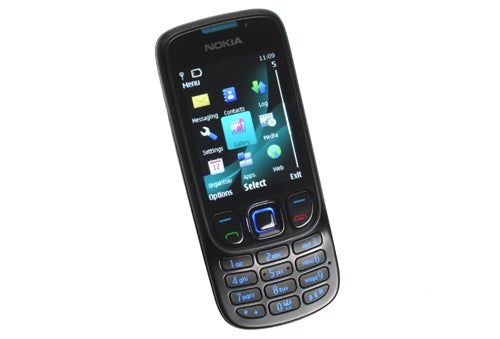
Verdict
Key Specifications
- Review Price: £84.97
Nokia’s smartphone division may have taken a battering recently due to a string of underwhelming handsets, including the N900 and N97, but the company does have a long history of producing well built, easy-to-use candybar phones like the immensely popular 6300 and the equally loveable 6700. The latest model in this dynasty is the 6303 and it looks to be a worthy successor.
The primary thing that has set these handsets apart from the masses is their build quality and the 6303 doesn’t disappoint. While the bulk of the body is made of plastic, the front section that surrounds the screen and keys is made of stainless steel, as is the battery cover. The result is a phone that feels very solid and has a reassuring weight to it, though at 96g it’s by no means heavy. Its slim body and rounded edges also mean it slips easily into a pocket and is comfortable to hold. If you’re not a fan of the black and blue finish, a silver model is also available.
The controls on the 6303 are simple, with a keypad sitting below a D-pad and buttons for call answer, call end, and soft menus positioned under the 2.2in, 240 x 320 pixel LCD screen. Up top is a power button-cum-keypad lock-cum-profile selector while the right edge adds a volume rocker and the left edge is barren. 
The main buttons are all large enough to easily locate and though they don’t have the sharpest of breaks, it’s still easy to tell when you’ve pressed a key or not. Certainly, we found we were able to type at a decent pace with few mistakes. The only real downside is that the D-pad is a little small, but it’s only a minor annoyance. 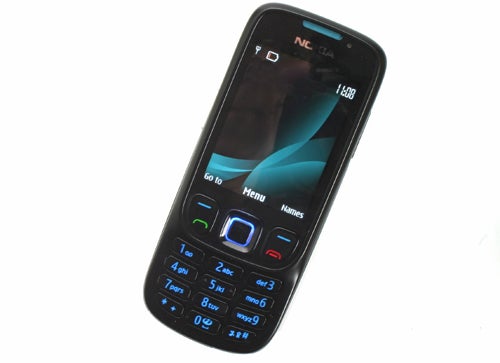
As for that screen, it makes both text and images sharp and crisp – a virtue of its relatively high resolution in such a small frame. It’s also bright and colourful and has superb viewing angles; so good, in fact, that colours and contrast stay true almost to the point of viewing the display completely side-on. The screen is also transflective, meaning it is still readable when the backlight is turned off. This enables it to display a basic readout showing date, time, and profile when the 6303 is in standby. The screen’s slight downside is its surface, which is a relatively soft plastic that we would imagine could scratch easily. However, a colleague has a two year old Nokia 6300 that has a very similar screen finish and it’s still in great condition (it’s never been protected by a case, either). 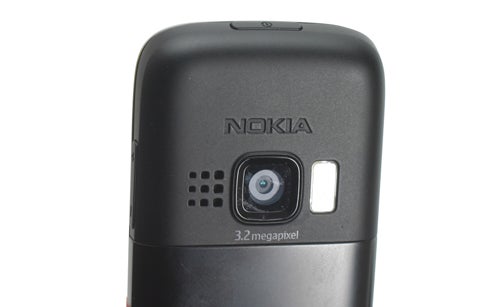
On the back of the phone is the single speaker, which delivers surprisingly rich and powerful audio. Next to this is the camera, which has autofocus and a dual-LED flash. It’s nothing too clever but is definitely a step up from what you’d expect at this price. It can take a useable picture in most scenarios and the flash has a decent range of a couple of metres. The app is also quick to load so you shouldn’t miss that vital hilarious antic.
More positive news comes when we look at the bottom of this phone where lurks a standard 3.5mm headphone jack. Along with a simple to use music player and a microSD card slot underneath the battery, which supports cards up to 4GB, this makes for a great little mp3 player. The only bug bear is that music doesn’t pause when you unplug your headphones. It’s not all rosy, though, as the micro-USB socket – used for connecting the phone to a PC – doesn’t charge the phone. Instead, you must use the tiny, cylindrical proprietary charging socket. Thankfully, battery life is a strong point and you should be able to get around a week out of it with casual use. 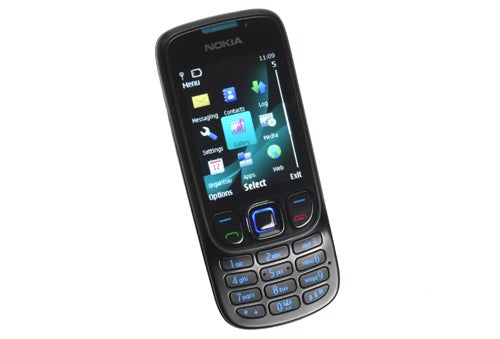
Navigating your way around the 6303 is simplicity itself thanks in part to the speediness of the Symbian S40 operating system. While we’ve had cause to complain about Nokia’s continued use of Symbian in more powerful phones like the N97, where it’s simplicity and limited support for touchscreens feels awkward, on a basic phone like this it really shines. Just about the entire interface conforms to a basic set of layouts: a grid of icons for the main menu, lists of items for sub menus, and further text-only lists for options. Apart from learning where a few less obvious functions and features are located, it’s a breeze to use.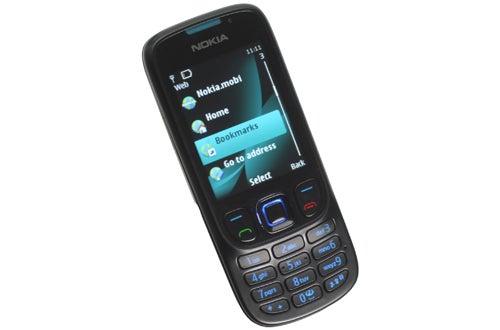
We were also surprised by the quality of the games. We could take or leave the Brain Training clone and peculiar City Bloxx games, but the LocoRoco clone and Sudoku games were sufficiently entertaining. It’s also easy to get hold of other games and apps through the OVI app store, for activities such as accessing your favourite social networking sites and uploading photos to Flickr. However, their functionality is limited with no support for push notifications or multitasking so this certainly isn’t a rival to any smartphone. The default web browser is rather limited as well with a clunky interface and an inability to display full scaled web pages – it can show full web pages but at a maximum of 50 per cent zoom. You can install Opera mini, though, to get a slightly better browsing experience. 
Of course, as this is a basic phone, arguably it’s most important feature is call quality and thankfully the 6303 didn’t disappoint. It produced a smooth natural tone through the earpiece and likewise from the microphone. The loudspeaker being on the back isn’t ideal for conference calling but otherwise this phone passed our calling test with flying colours.
”’Verdict”’
The Nokia 6303 is one of the best ‘basic’ phones on the market. It’s small and slim yet easy to handle, and is superbly well made. It’s also great for making calls on, has a vast battery life, doubles as a great little mp3 player and even has a half decent camera. It has its limitations when it comes to browsing the web and keeping up with your social network but the only real fly in the ointment is its use of a proprietary charging socket, which in this day and age is a major faux pas.
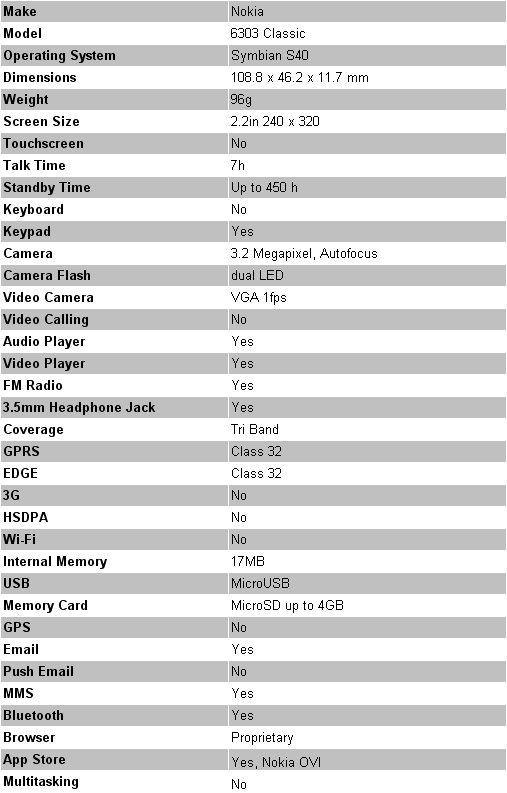


How we test phones
We test every mobile phone we review thoroughly. We use industry standard tests to compare features properly and we use the phone as our main device over the review period. We’ll always tell you what we find and we never, ever, accept money to review a product.
Trusted Score
Score in detail
-
Performance 8
-
Design 9
-
Value 9
-
Features 6
General
| Operating System | Symbian OS |
| Height (Millimeter) | 108.8mm |
| Width (Millimeter) | 46.2mm |
| Depth (Millimeter) | 11.7mm |
| Weight (Gram) | 96g |
| Available Colours | Black, silver |
Display
| Screen Size (inches) (Inch) | 2.2in |
| Screen Resolution | 240x320 |
| Touchscreen | No |
Battery
| Talk Time (Minute) | 420m |
| Standby Time (Hour) | 450hr |
Storage
| Internal Storage (Gigabyte) | 0.017GB |
| Camera (Megapixel) | 3.15 Megapixel |
| Front Facing Camera (Megapixel) | No Megapixel |
| Camera Flash | Dual-LED |
Connectivity
| Bluetooth | Yes |
| WiFi | No |
| 3G/4G | No |
| 3.5mm Headphone Jack | Yes |
| Charging/Computer Connection | microUSB |
Misc
| GPS | No |

